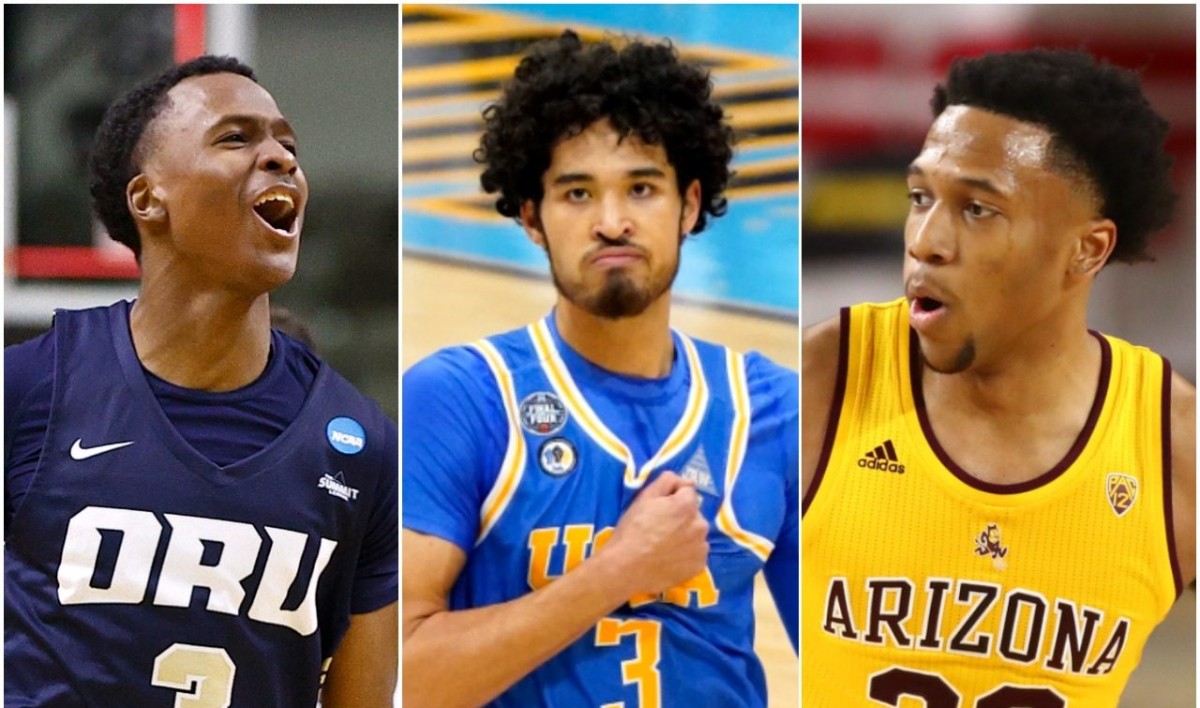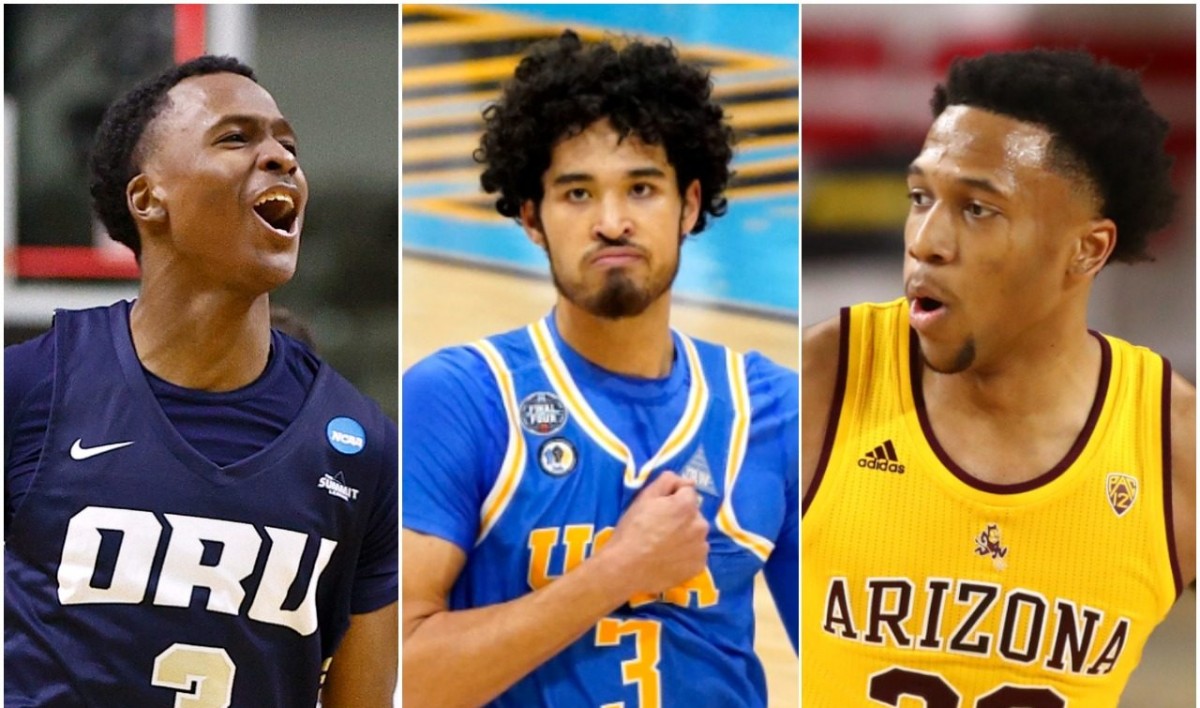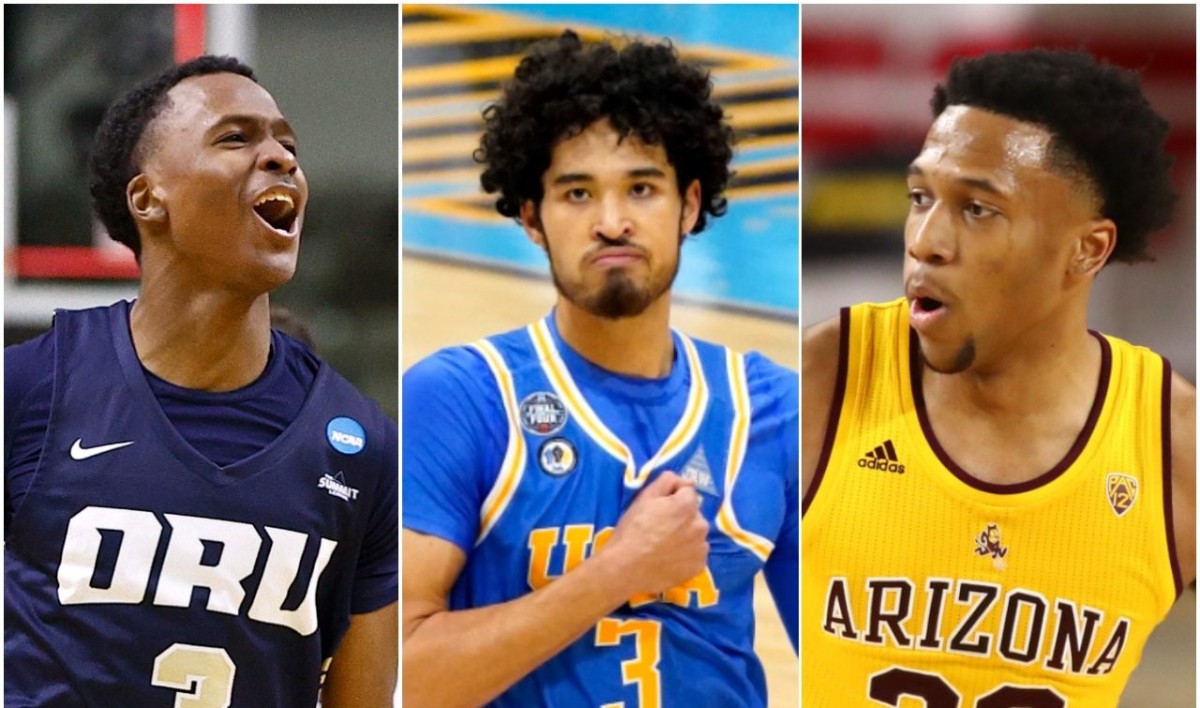[jwplayer VwfnWxAP]
In an instant, silence filled the Las Vegas arena.
When a defender plucked Denzel Mahoney’s teammate at halfcourt, Mahoney planted his foot and bolted in the opposite direction. Down big at halftime to a powerhouse opponent in the Fab 48 Tournament, where the best high school prospects took center stage, Mahoney’s team roared back to trail by just one.
Rubber on glass echoed throughout the arena, Mahoney pinning the ball to the backboard. And then, in an instant, it was all over.
Mahoney lay motionless under the rim.
The summer before his senior season, the Florida A8 State Player of the Year wouldn’t receive any high-major NCAA offers; coaches throughout the arena heard the pop loud and clear.
“Why me?” Mahoney cried as trainers carried him off of the court. “What did I do wrong?”
To continue his basketball journey Mahoney would have to adapt and overcome. It’s how he went from missing out on varsity to high-school stardom, from tearing his ACL to starring at Southeast Missouri and from struggling in a diminished role to becoming the Big East’s Sixth Man of the Year at Creighton.
Mahoney’s malleability would be his saving grace throughout his life. But for now, the same trait of his knee was all that mattered.
*****
After the final buzzer sounded, Mahoney tightened his focus.
Mahoney wasn’t thinking about the game’s result. As players exited the court, Mahoney ran onto the hardwood to put up shots.
Mahoney had a problem, though. He struggled to lift a basketball nearly as large as he was and struggled to launch the ball anywhere near the rim. This court wasn’t fit for a baby.
Growing up in Oviedo, Florida, one-year-old Mahoney attended all of his brother Darrell Hamilton’s high school basketball games, infatuated with the sport from as early as he could remember.
“Ever since then, I want to be just like him,” Mahoney said.
After games, he’d chase after the ball, attempting to sink shots.
Hamilton embraced his little brother, allowing him to hang around his basketball team as he pleased, despite some of his friends mistaking Mahoney for his son.
“I treated him like he was my little kid although he was my brother,” Hamilton said.
Even as Hamilton went off to college in Kansas to play basketball, Mahoney made trips to watch his brother take the floor. Playing his last two years in St. Augustine, Florida, was “instrumental” for Mahoney, as Hamilton says, being closer to his brother and his basketball games.
When Mahoney reached preschool, his mother, Hazel, quit her job to focus on time with her son and make sure he could further his love for basketball.
“She sacrificed her work for me,” Mahoney said. “[She] made sure I learned and got everything I wanted.”
Off the court, Mahoney’s soft-spoken nature didn’t draw attention. But on the court, even a young Mahoney started to turn heads.
From the age of three, Mahoney played organized basketball, dominating YMCA and church leagues. By fifth grade, Mahoney played AAU basketball.
Unlike most kids, Mahoney spurned casual pickup games for shooting guns and full-fledged workouts. As a seventh-grader, Mahoney had 24/7 access to an at-home gym, owned by family friend Irwin Hudson. There, Mahoney’s handling and passing improved, despite being forced to play center for most of his teams as the tallest kid.
“He never wanted to leave the gym,” Hamilton said.
As Mahoney prepared for high school basketball, one rule devastated Mahoney, all of his work for naught: At Orlando Christian Prep, no freshmen would be allowed on varsity.
Mahoney took up soccer and football in eighth and ninth grade. Nothing would replace basketball, though. For a better opportunity, Mahoney transferred to Hagerty High School, where he’d eventually flourish.
To Hamilton, Mahoney’s devotion to basketball was always evident. But when Mahoney was in 10th grade, Hamilton realized he’d be a special player.
As Hamilton watched sophomore Mahoney play, he sat in the stands, confused. Mahoney’s team played a spread offense, whizzing the ball around the court.
“I was thinking to myself, ‘Man, how come you’re so passive?'” Hamilton said.
When the game ended, Hamilton glanced at the score sheet, stunned. Mahoney spent the whole game moving the ball like the team-first player he was. How on earth did he end up with 24 points, eight rebounds and six assists?
After the game, Hamilton asked Mahoney to be more aggressive. If he could do that despite his passivity, Hamilton knew how devastating he could be if he pumped the gas harder. That year, Mahoney led his conference in scoring.
At that point, Hamilton knew his brother flipped a switch.
“When I saw that he was playing that way that’s when I really saw that he understands the game, that he gets it and he’s going to be a really good player at the next level,” Hamilton said.
From there, Mahoney continued to accrue awards and championships, carving his path to play Division I college basketball. But during the height of his recruitment, playing with his AAU team, Q6 All-Stars Elite, at the Fab 48 Tournament in Las Vegas, one awkward landing derailed everything.
Hamilton had never seen Mahoney jump as high as he did on that fateful leap, the rejection that would set him back months and scare off college coaches.
“It took the air out of the gym,” Hamilton said.
Hamilton hoped it wasn’t serious. A bad sprain, maybe. A minor tear. But as trainers carried Mahoney off of the court and as the days went on, MRIs confirmed the worst: A torn ACL.
For the rest of the tournament, Hamilton stayed at Mahoney’s side, as he limped around his hotel room in a boot and crutches. He did all he could to keep Mahoney’s spirits up.
“Things happen,” Hamilton would tell his brother. “There’s nothing that you did wrong.”
All it took was one coach to believe in Mahoney, and that coach was Southeast Missouri’s Rick Ray.
“The way sports medicine is today, I’m 100% confident you’re gonna bounce back,” Ray told Mahoney. “And when you do, I’ve got a scholarship for you.”
Mahoney would miss his senior season rehabbing his ACL injury. He had a scholarship at a Division I school. There was no reason to risk that certainty.
Mahoney rehabbed his knee in Orlando, battling through the physical and mental rigors of his injury.
“The hardest thing was just the mental aspect of it,” Mahoney said.
Through all of the hardship and the doubt, a milestone came five months after surgery. Finally, his knees were strong enough to begin jogging again. To keep taking steps back towards the court.
“I was just smiling ear to ear,” Mahoney said.
*****
When Damien Jefferson first saw Mahoney’s raggedy, spiked hair and goofy glasses, he had one wish: Don’t let this kid be my roommate.
Jefferson doesn’t know why, but he dreaded sharing a room with the Southeast Missouri transfer. But he and Mahoney would share a dorm and, in time, a transformative bond.
Jefferson understood the challenges of transferring to Creighton, moving to Omaha after playing his freshman year at New Mexico. The two transfers shared a common pain.
Moving from Florida to Missouri was difficult enough for Mahoney. Aside from leaving his family, Mahoney endured the harsh Cape Girardeau winters, at least compared to tropical Oviedo.
On one snowy October morning – unheard of for a native Floridian – Mahoney awoke in disbelief. The sheen of white covering the ground outside his window had to be fake. But through the distance from his family and through the cold, Mahoney kept a positive attitude.
“Not one time did he complain, he actually embraced it, and was like ‘Send me another coat’,” Hamilton said.
Mahoney dominated opponents at Southeast Missouri, winning awards like conference Freshman of the Year and scoring nearly 20 points per game. Yet, Mahoney had a goal, one he believed would go unrealized at Southeast Missouri.
Mahoney wanted to play on the biggest stage, to reach the NCAA Tournament. Ohio Valley Conference powerhouses Murray State and Belmont run the conference — Southeast Missouri has won the conference once in history.
With more left to accomplish, Mahoney left Missouri and everything that came with basketball stardom, transferring to Creighton, even further from his home, without a friend for hundreds of miles.
And despite Jefferson’s initial impression of his new roommate, Mahoney turned a skeptic into a best friend quickly. Jefferson remembered what it was like to know nobody on campus.
“He motivated me and he knew what I was struggling with,” Mahoney said. “I’m used to being the guy.”
At Creighton, Mahoney transitioned from carrying the scoring load to coming off of the bench. He struggled to shake old habits, often taking shots the coaches weren’t fond of.
As much as Jefferson helped his roommate’s transition, Mahoney’s positivity and humor captivated Jefferson.
“He will never let you have a bad day,” Jefferson said.
When Jefferson sulked after a bad game, Mahoney would blast old-school music and host a mini-concert in their living room to lift his roommate’s spirits.
On the court, Mahoney adapted quickly. A team-first player, Mahoney reverted to his passivity of old, finding a role in Creighton’s rotation quickly.
“I had to accept the role that was given to me and make the best of it in any way possible, leave my imprint on the game,” Mahoney said.
Embracing this role, Mahoney engineered a Big East Sixth Man of the Year campaign. Mahoney wasn’t a good shooter when he was little, nor did he know about his 6-foot-11 wingspan, yet he played the 3-and-D role for the Bluejays.
The sacrifices Mahoney made led to a share of the Big East regular-season title, the first in program history. Due to the coronavirus pandemic, he wouldn’t reach an NCAA Tournament this season. But at Creighton, Mahoney accomplished more than he ever thought he would.
“Being a part of that team and making that push and making history, I think it was worth it,” Mahoney said. “Everything was worth it.”
*****
Darrell Hamilton’s phone buzzed.
“You know your brother played the other day,” the caller said.
“No way, what’d he do that for?” Hamilton replied.
“He said he was feeling good,” the caller responded.
Mahoney wasn’t supposed to play a second of competitive basketball until he reached Cape Girardeau. His scholarship at Southeast Missouri wasn’t going anywhere.
Not even an ACL tear could pry Mahoney away from the court for long. His coach wasn’t going to let Mahoney play more than 20 minutes in his senior season debut. The risk wasn’t worth it. But Mahoney’s team found itself down big, needing a spark to secure a victory.
Seven months earlier, injury kept Mahoney from finishing his comeback.
Seven months and 24 points later, Mahoney led his Hagerty team to victory.
“The guy went out on his own merit,” Hamilton said. “He knew his body, he was confident in himself.”
The pandemic allows Hamilton to spend more precious time with his brother. Even when Mahoney lived miles away, the brothers cherished spring and summer breaks together.
Mahoney has to remain focused, though. He has big plans, goals he writes down and executes. Pandemic or not, Mahoney still has an NBA dream to train for
“Over time, seeing that evolution and maturation him growing up, [he] really turned from a boy to a man,” Hamilton said.
Mahoney spends his days where he always did, at Irwin Hudson’s gym, getting hundreds of shots up, lifting weights and watching film. When Mahoney’s next basketball opportunity calls, he has to be ready.
Almost five years after his injury, Mahoney struggles to trust his own knees at times. Certain movements are still dubious. What if his ACL gives out again?
Amongst the deafening silence within his own head, Hamilton’s words echo louder.
“In the end, it’s all going to be worth it.”
[lawrence-related id=17826,17129,16887]
[vertical-gallery id=14282]




